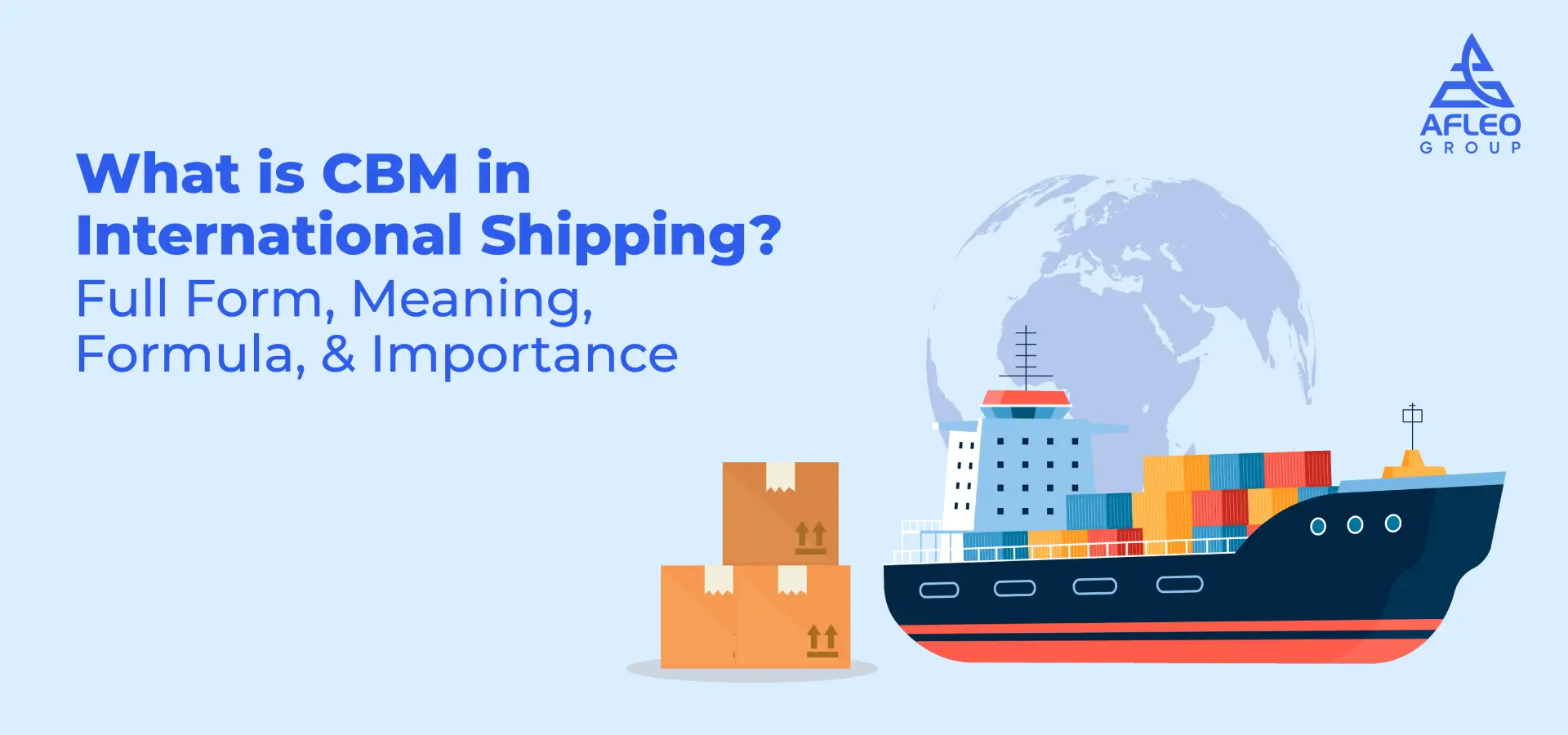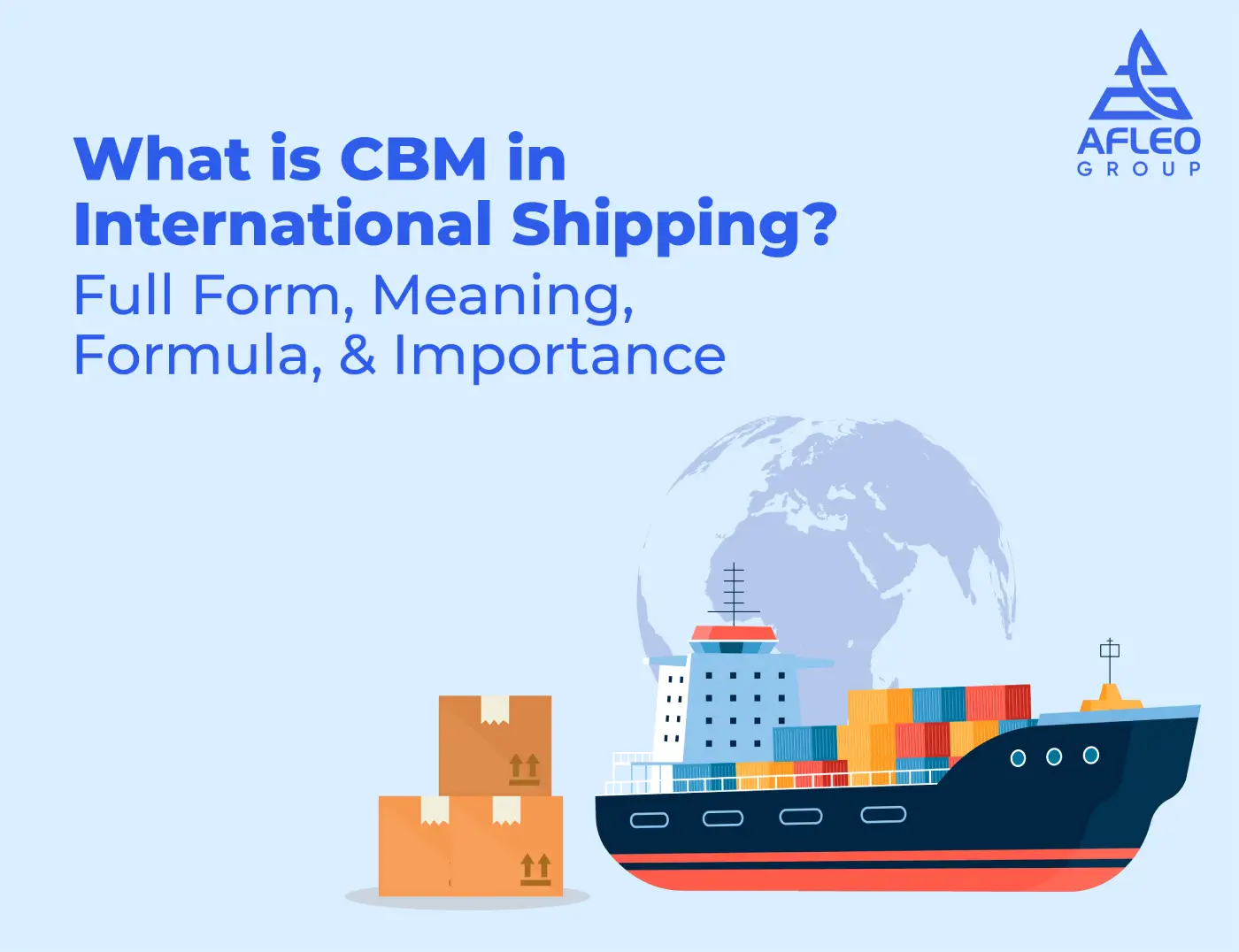
Picture this: A Delhi-based electronics importer contracted for an LCL (Less than Container Load) shipment from China. The supplier provided approximate box sizes and the carrier estimated 18 CBM. In reality, when measured by customs, the cargo was only 14 CBM. The importer already paid for the extra volume and it took weeks to resolve the dispute. This is a typical scenario where a CBM calculation error results in unnecessary expenses and delays.
In global shipping, CBM (cubic meter) is among the most critical calculations. It will tell you how much space your cargo takes up, how much you owe in shipping costs, and even whether your products will fit in a container. You may be a novice exporter or a seasoned logistics professional, but learning about CBM is crucial to maximizing your costs and minimizing fulfillment complications.
At Afleo Logistics, we frequently assist importers and exporters with correct CBM calculations, container planning and customs declarations, saving them considerable amounts of money and avoiding shipping disputes. Let’s explore in depth the definition of CBM, its formula, its role in various shipping modes, and why it is so important in international trade.
Full form of CBM and meaning in shipping
- Full form: CBM = Cubic meter
- Definition: A CBM is a measurement of cargo volume calculated in cubic meters. It is an international standard for calculating shipping space requirements.
Why is CBM used?
- In ocean shipping, particularly LCL shipments, carriers are billed freight by cargo volume (CBM).
- In air transport, CBM is used to calculate volumetric weight, which is contrasted with the actual weight for billing.
- In FCL cargo, CBM helps companies select the right container so that there is no underutilization or overselling.
Simply put, CBM allows shippers and carriers to communicate in a common volume language to ensure equitable freight billing.
Why is CBM important in global shipping?
Set freight charges
For LCL cargo, freight charges are by CBM. For example, with a freight charge of $60/CBM and your cargo volume of 10 CBM, your freight charge will be $600.
Container planning
For FCL shipments, CBM helps you choose whether you want to book a 20-foot container (28 to 30 CBM), a 40-foot container (58 to 60 CBM), or a 40-foot High Cube (66 to 68 CBM).
Customs and carrier compliance
Customs officials and shippers tend to remeasure CBM. In the event that your declared CBM does not substantially match, you risk being charged fines, delivery delays or re-measurement charges.
Optimization of logistics costs
A difference of a few centimeters in packaging dimensions can increase the CBM and, consequently, the cost. Accurate CBM informs us of areas to save costs.
How to calculate CBM: the formula
The universal formula is:
Length (m) × Width (m) × Height (m) = Volume in CBM
Example 1:
- A box measuring 1.2 m (length) × 0.8 m (width) × 0.6 m (height)
- MBC = 1.2 × 0.8 × 0.6 = 576 cubic meters
Example 2:
- A pallet of 1.2m × 1.0m × 1.5m
- MBC = 1.2 × 1.0 × 1.5 = 8 cbm
Conversion standards
Since not all companies use metric measurements:
- 1 inch = 0.0254 meters
- 1 foot = 0.3048 meters
When the dimensions are in feet/inches, convert them to meters first and then use the formula.
CBM conversion table for most common load sizes
| Loading dimensions (cm) | CBM (approx.) |
|---|---|
| 100 × 100 × 100 | 1.00 cubic meters |
| 120 × 100 × 100 | 1.20 cubic meters |
| 120×80×80 | 0.77 cubic meters |
| 60×40×40 | 0.10 cubic meters |
| 50 × 50 × 50 | 0.13 cubic meters |
This simple table helps companies estimate cargo volume without calculation problems.
CBM in various shipping situations
1. LCL cargo
- More frequent application of CBM.
- Example: Freight cost = $45/CBM. If load = 8 CBM, then cost = $360.
2. FCL load
- It is charged per container, not per CBM.
- But CBM is crucial to ensuring that you are not reserving a 40-foot container for cargo that easily fits into a 20-foot container.
3. Air transport
- Air transport uses volumetric weight:
Formula = ((L × W × H in cm) ÷ 6000 = Volumetric weight (kg)
- CBM is involved in converting cargo volume to equivalent weight.
CBM and container capacity
- 20ft container: ~28–30 cubic meters
- 40ft container: ~58–60 cubic meters
- 40 foot tall cube: ~66–68 cubic meters
Example: When you have 32 CBM cargo, it is good to book a 40ft container. However, when you have 27 CBM, you can save by booking a 20-foot container.
Knowing this avoids wasting space and unnecessary expenses.
Common errors when calculating CBM
Skip the packaging
Companies will calculate product dimensions but leave out boxes and pallets, which increases CBM.
Mixing units
Using feet in one unit and meters in another can cause significant errors.
Do not account for irregular cargo
Large loads, such as machinery, may require volumetric weight calculations, not simply CBM.
Rounding errors
Small rounding discrepancies lead to disputes between carriers.
Tips to save shipping costs by using CBM
- Maximize packaging – Minimize empty space inside boxes to reduce CBM.
- Consolidate deliveries – Combine several smaller deliveries into one to minimize CBM charges.
- Apply standard pallet sizes: Helps maximize the use of space within containers.
- Work with experts – Expert logistics services like Afleo can ensure proper measurement and avoid remeasurement fines.
How Afleo can help
Here at Afleo Logistics, we don’t just move cargo. We help customers maximize shipping by:
- Accurate CBM Calculation – Avoid excessive payments and litigation.
- Assistance in customs clearance – Verify CBM information on invoices and packing lists.
- DGFT and IEC Compliance – Integrate correct cargo information with regulatory filings.
- Pre-shipment checks – Inspect packaging, size and documents before releasing cargo to carriers.
- Cost optimization strategies – Recommend container size, consolidation and transportation planning.
By leveraging our expertise, Indian businesses save time, money and effort while maintaining international trade compliance.
Contact Afleo today and make your shipping cost-effective, compliant, and easy.
Frequently asked questions
CBM is cubic meter, the measurement of cargo space.
A typical 20-foot container can hold between 28 and 30 CBM.
Yes, CBM is translated into volumetric weight to compare with actual weight for billing purposes.
No, it is based on value and HS code, but CBM may affect freight and handling charges.
CBM calculates volume, while volumetric weight converts volume into an equivalent weight (for air transport).
Final thoughts
CBM may seem like just a number, but it is actually one of the most important determinants of shipping cost estimating, container planning, and compliance. A CBM calculation error can lead to overpayments, disputes and shipping delays, while a proper calculation saves companies thousands of dollars in logistics costs.
At Afleo Logistics, we ensure that our customers never lose money due to inaccurate measurements. From CBM calculation to customs clearance and DGFT compliance, we take care of every detail so that your shipment arrives safely.
Ready to streamline your shipments? Contact Afleo today for expert help in CBM calculation, documentation and end-to-end logistics services.
Do you have any questions? Please complete the following form to contact us.
Notice: JavaScript is required for this content.
#CBM #maritime #transport #Complete #form #meaning #formula #importance









